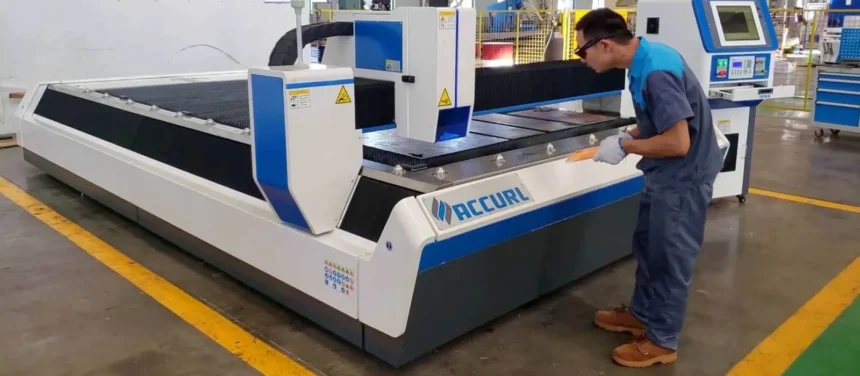CNC machining has transformed manufacturing by using pre-programmed software to control tools and machinery, delivering precision and efficiency. It plays a crucial role in creating products like aerospace components and medical devices. This guide explores the five main types of CNC machines, their functions, and their impact on various industries.
CNC Milling Machines
CNC milling is one of the most common and versatile forms of CNC machining. It involves using a rotating multi-point cutting tool to remove material from a stationary workpiece. The computer controls the movement of the tool and the workpiece along multiple axes, allowing for the creation of complex shapes, slots, holes, and other features with incredible accuracy.
The Process
In a typical CNC milling operation, the workpiece is securely clamped onto a bed or table within the machine. The computer-controlled spindle, which holds the cutting tool (like an end mill or drill bit), rotates at high speeds. The machine then moves either the table holding the workpiece or the spindle itself along several axes—typically three (X, Y, and Z) or even up to five for more complex geometries. As the rotating tool comes into contact with the workpiece, it methodically shaves away material to achieve the final desired shape.
Common Applications
The precision and versatility of CNC milling make it indispensable in numerous fields. Common applications include:
- Prototyping: Creating detailed and functional prototypes for new products.
- Aerospace: Manufacturing complex engine components, structural parts, and housings.
- Automotive: Producing engine blocks, transmission parts, and custom molds.
- Electronics: Machining enclosures, heatsinks, and custom circuit board components.
CNC Turning Machines (Lathes)
While milling involves a rotating tool and a stationary workpiece, CNC turning reverses that dynamic. In a turning process, the workpiece itself rotates at high speed while a stationary single-point cutting tool removes material. CNC lathes are the modern evolution of the traditional lathe, offering automated precision for creating cylindrical parts.
The Process
The workpiece, typically a cylindrical block of metal or plastic, is held in a chuck and rotated rapidly. A computer-controlled cutting tool is mounted on a turret, which moves along two axes (X and Z) to cut and shape the rotating material. This process is ideal for creating symmetrical, cylindrical, or conical parts. The machine can perform various operations, including facing, parting, drilling, knurling, and thread cutting.
Common Applications
CNC turning is the go-to method for any component with a cylindrical profile. Its applications include:
- Manufacturing: Creating shafts, rods, pins, and custom fasteners like bolts and screws.
- Automotive: Producing axles, camshafts, and other cylindrical engine parts.
- Medical: Crafting precision surgical instruments and implantable devices.
- Electronics: Making custom connectors, knobs, and fittings.
Electrical Discharge Machining (EDM)
Electrical Discharge Machining (EDM) is a non-traditional machining process that uses electrical sparks to shape metal. Unlike milling and turning, EDM does not rely on mechanical force to remove material. Instead, it erodes the material through a series of controlled electrical discharges between an electrode (the tool) and the workpiece, which must be electrically conductive.
The Process
The workpiece and the electrode are submerged in a dielectric fluid, which acts as an insulator until a specific voltage is reached. When the voltage is applied, a powerful spark jumps across the gap between the tool and the workpiece, melting and vaporizing a tiny portion of the material. This process repeats thousands of times per second, gradually eroding the workpiece to match the shape of the electrode. There are two main types: wire EDM, which uses a thin wire as the electrode, and sinker EDM, which uses a custom-shaped electrode to “sink” into the material.
Common Applications
EDM is uniquely suited for tasks that are difficult or impossible with traditional machining methods. Its capabilities shine when working with extremely hard metals or creating intricate features.
- Tool and Die Making: Creating complex molds, dies, and stamping tools with sharp internal corners.
- Aerospace: Machining high-strength, temperature-resistant alloys for turbine blades and engine components.
- Medical: Manufacturing intricate surgical tools and implants from hardened steel or titanium.
CNC Plasma Cutting Machines
For cutting through thick metal plates, CNC plasma cutters are an efficient and powerful solution. This process uses a high-velocity jet of ionized gas—or plasma—to melt and cut through electrically conductive materials. When integrated with CNC technology, plasma cutting becomes a highly accurate and automated process for fabricating metal parts from flat sheets.
The Process
A plasma cutter works by sending an electric arc through a gas (like oxygen, nitrogen, or argon) that is passed through a constricted opening, or nozzle. This process heats the gas to an extremely high temperature, ionizing it and turning it into a plasma jet. The CNC system guides the plasma torch over the surface of the metal sheet, melting a precise path through the material. A high-velocity gas stream then blows the molten metal away, leaving a clean cut.
Common Applications
Plasma cutting is widely used in industries that require fast and efficient cutting of metal sheets and plates.
- Industrial Fabrication: Cutting parts for machinery, structural steel, and large equipment.
- Automotive Repair and Customization: Fabricating custom brackets, frames, and body panels.
- Construction: Creating metal signage, decorative panels, and structural components.
- Metal Fabrications: Often used for custom metal fabrications like those offered in Utah, where precision cutting of steel, aluminum, and stainless steel is required.
CNC Laser Cutting Machines
Similar to plasma cutting, CNC laser cutting uses thermal energy to cut materials. However, instead of a plasma jet, it uses a highly focused, high-power laser beam. The CNC system precisely controls the movement of the laser head to cut, engrave, or etch intricate patterns into a wide range of materials, including metals, plastics, wood, and composites. Because of its precision and minimal heat-affected zone, laser cutting is ideal for detailed work.
Conclusion
CNC machines are essential in modern manufacturing, each designed for specific tasks and materials. Technologies like CNC milling, turning, EDM, plasma, and laser systems enable the creation of both simple and complex components with precision and efficiency. Understanding their functions helps manufacturers choose the right process for their designs.








